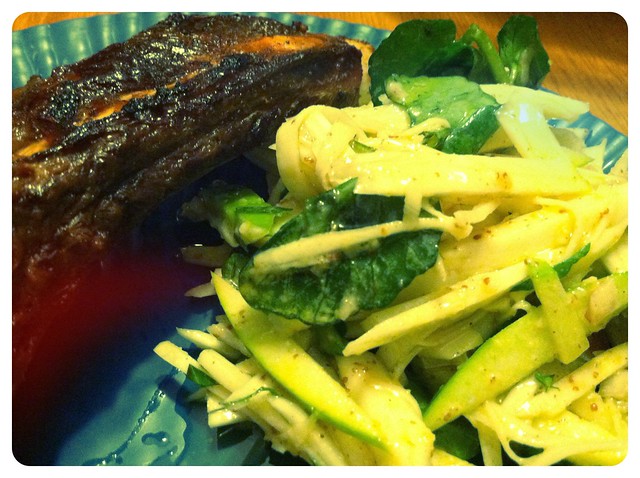Ever since Michael Symon competed on Next Iron Chef, I have been smitten. I knew before the results were ever announced that he would be the winner. He just had such a zeal for life and infectious laugh that it was - and still is - really hard to dislike him, even when he says things you might disagree with.
I reviewed his first cookbook, Live to Cook, back in 2011, and was incredibly excited over the fact that I actually learned some new things in that book. By that point I was worried that I had exhausted all of my home cook knowledge and that all cookbooks I read were just going to be a regurgitating of all the other recipes I'd ever read in my entire life. With Live to Cook, I not only discovered some new and flavorful recipes, but I also learned a great deal from Symon's teachings and techniques.
I wouldn't say I learned as much from Carnivore, but this book was a great reiteration of Symon's food philosophy, and I appreciate that his focus is and always has been on quality ingredients.
So what is Symon's food philosophy? Well, besides the importance of focusing on ingredients, Symon wants his readers to understand the importance of balance in a dish - the need for a variety of flavors and textures. There's nothing he despises more than a big hunk of meat swimming in a rich sauce only to be served with bland mashed potatoes. That is why whenever you find yourself dining at a Michael Symon restaurant, you will always be served some sort of bright, acidic component to go along with your big hunk o' meat, as is always the case whenever I dine at his Detroit restaurant, Roast, where, as an example, instead of potatoes to go along with this rich meat dish, it was served with a spicy pickled relish:
So despite the fact that the meat is obviously the star in this book, equally as important are the sides, which are not your typical mashed potatoes and gravy. Instead you will find bright pops of flavor like a grapefruit salad with feta and kalamata olives, apple and celery root salad, shaved Brussels sprouts served with a vinaigrette, grapefruit tabbouleh, the list goes on, but each side dish is meant to brighten and complement the meat's richness, not compete with it. As Symon says on p. 13:
I strive to counter meat's inherent richness, fattiness, and intenseness (all the things we love about it) with an equal and appropriate measure of acid, salinity, and texture. This formula is what makes a dish a glorious symphony as opposed to a sad one-note song.
But let's talk about the real star, the meat, shall we? This book is divided into chapters thusly:
- Beef
- Port
- Lamb & Goat
- Poultry
- Game
- Sides
All in all, this was a wonderfully organized book with beautiful photos and mouth-watering recipes. I initially checked this book out at the library but decided I liked it so much that I needed to own it and purchased my own copy. I have since made three recipes from the book that that were quick and easy and not intimidating in the slightest -- I need to work up the courage for the roasted bone marrow.
 |
| Apple and celery root salad from Michael Symon's Carinvore |
Despite the fact that the dishes I tried didn't bowl me over, I found them to be a great starting point for tweaking. Symon gave me the tools (focus on balance and quality ingredients), now I just have to use these recipes as a starting point.
Apple and Celery Root Salad
Symon suggests using this as an accomainament to pork
Serves 8
2 granny smith apples
1 medium celery root, peeled and cored
1/2 cup cider vinegar
kosher salt
1 shallot, minced
2 tablespoons grainy mustard
1/2 cup extra virgin olive oil
2 tablespoons chopped, fresh tarragon (don't leave this ingredient out! It makes the dish!)
1 cup watercress, tough stems removed
Slice the apple and celery root into long, thin matchsticks either by hand or with a mandoline. Put in a nonreactive bowl and toss with the vinegar. Add a large pinch of salt.
In a small bowl, combine shallot and a good pinch of salt. Whisk in the mustard, olive oil, and tarragon. Pour the dressing over the apples and celery root and toss to combine. Let sit for about 20 minutes.
When ready to serve, toss in the watercress.



I love bone marrow -- so good luck in your experiments with it. This sounds like a book I might check out from the library. Your mixed results makes me less interested in buying it.
ReplyDeleteMy sister-in-law and I met Michael Symon after a taping of The Chew; what a nice guy! The grapefruit feta and kalamata salad sounds tasty. I really enjoyed your post.
ReplyDeleteI would LOVE to meet Michael Symon. He is so adorable. He definitely makes The Chew worth watching.
DeleteGreat post! Thanks Beth. Have a good week.
ReplyDeleteI've used a lot of cookbooks that benefit from a little 'tweaking'... and am lucky that my husband actually enjoys this process. Great review!
ReplyDeleteI share your love of Michael Symon...
ReplyDeleteI want to track down a copy of this too. Some of the sides you mentioned sound really good. Also, I love with a dedicated family of carnivores, so I'm always looking for some good meat recipes.
ReplyDeleteI love Michael too. His laugh is contagious. Will have to see if the library has this.
ReplyDeleteOooh, I bet the grapefruit, feta, olive salad is delicious. I love watching Michael Symon on The Chew. He cracks me up.
ReplyDelete